
Craig Bradford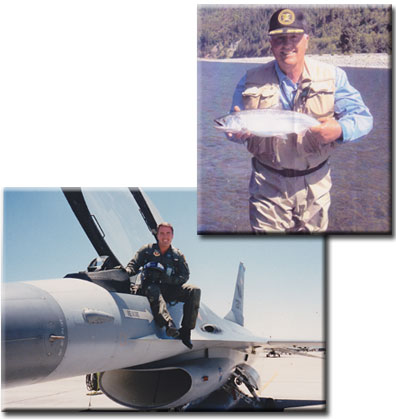
The bottom line is that we love all Campbell High graduates, no matter what class year or what they became in life. Before proceeding, I first would like to distantly thank the Campbell Kiwanis Club retroactively for its magnificent 4-year scholarship presented to me on graduation day in 1962 to a university of my choice. That helped more than words can describe.
Personal Record
What happened with me prior to military life might be best categorized as trouble. Yet, when one stands back and considers events after high school and before wearing a military uniform, one might see the way a higher power steered my life for the better and well beyond my personal control. I clearly had been on a collision course with “the dark side” prior to attending the University of Utah. A number of our classmates might attest to that.
After one troubled year at the University of California (Berkeley) in ‘62/’63, I became a fireman and then a fire truck driver with CalFire. I was employed as a fire engine driver at the Belmont Fire Station, without plans beyond that. My lungs had been badly seared during an apartment fire months earlier near San Jose State University when I was living with Joe Falcone at the Wheeler Apartments on 5th Street. It took me a long time to recover. With help from a football coach who needed a defensive back and/or a punting specialist, I received an offer to move to the University of Utah starting in the Spring 1965 semester. I soon found a place to live in Salt Lake City, and left California without looking back.
Initially pledged the Sigma Chi Fraternity . . . also became a punting specialist. My physician would not permit me to run until my lungs recovered, so we dropped the defensive back option. I was recruited in 1966 by Club Germania (a semi-professional soccer team in Salt Lake City) mostly for my punting ability, and became a $100-per-match weekend goalie until graduating from the university in 1968. Also worked for a large hotel chain during summers as a swimming pool manager and lifeguard. Money wasn’t a problem, for joining the Utah Musicians’ Union plus a number of successive university scholarships added significant income. In sum, all of this more than paid the way. I also became the President of the University’s superb orchestra and also played first trombone in the Stage Jazz Band. A friend recruited me for Utah’s Parachuting Team. After 97 jumps, I became Utah’s champion novice skydiver and won the Western U.S. Parachuting Division title in accuracy. A partial parachute failure almost killed me, which brought an end to that sport. (“Stupid is as stupid does.”) During that internationally turbulent period, the Vietnam Conflict began to absorb young men at an accelerating pace. The Dean of the University’s College of Biology, a close friend, counseled me to join the Air Force Reserve Officer Training Corp (AFROTC) to keep from being drafted. My goal, and also his, was for me to be admitted to the University of Utah Medical School’s Class of 1968 as “an adequately-paid, young military officer.” Such was the deal we initially cut with the AFROTC. At least 10 years as a USAF Flight Surgeon should have been my future. That said and immediately upon graduation (in 1968) plus publication of my graduate thesis, the Air Force canceled my medical school appointment and sent me to Undergraduate Pilot Training (UPT) at Vance Air Force Base in Oklahoma as a second lieutenant. The USAF’s argument was that it had been losing too many pilots in Vietnam. So, that’s how everything in my life changed dramatically.
Upon graduation from UPT, I was selected to fly jet fighters and prepare for combat in Southeast Asia. My training consisted of Global Survival, POW Survival, jet-fighter qualification in the AT-33 at Cannon AFB, Special Operations Training at Hurlburt Field in Florida followed by qualification as an Air Combat Controller in the OV-10A, and then Jungle Survival at Clark AB in the Philippine Islands. My first combat assignment in early 1970 was at Quang Tri AB just south of the Demilitarized Zone (DMZ) between South and North Vietnam. I became the Chief of Weapons, controlled U.S. Naval and USAF jet fighters on both sides of the DMZ, attacked targets on the Ho Chi Minh Trail to the east, and employed my own ordnance on enemy positions everywhere. After one year, the USAF sent me out of Vietnam and into northern Thailand, where the Central Intelligence Agency “secunded” me to serve in a civilian capacity with a small group of men with similar backgrounds to assist the Hmong Army in the Plain of Jars (northern Laos). I later became an assistant to Major General Vang Pao, Commander of the Hmong Army, when working with Thai mercenaries. As one of the few wounded survivors of the “Saint Valentines Day Massacre” in 1971, I was sent to the west side of the Austrian Alps to train as a glider pilot and relax. Having received an Austrian Class II license and upon recuperation somewhat from my wounds, the CIA then summoned me to respond to a request from the King of Laos to thwart Communist completion of a small highway from Moung Sinh, China, south across the Mekong River in northern Laos, and into Thailand. This deeply classified CIA effort was critical to stopping a Communist takeover of all of Southeast Asia and perhaps even avoiding WWIII. In 1987, the U.S. Congress declassified all U.S. activity in Laos. If you want to know more, you can read Jim Roper’s superb book, The Ravens, or my already published essay, “Burr Smith and One Raven.”
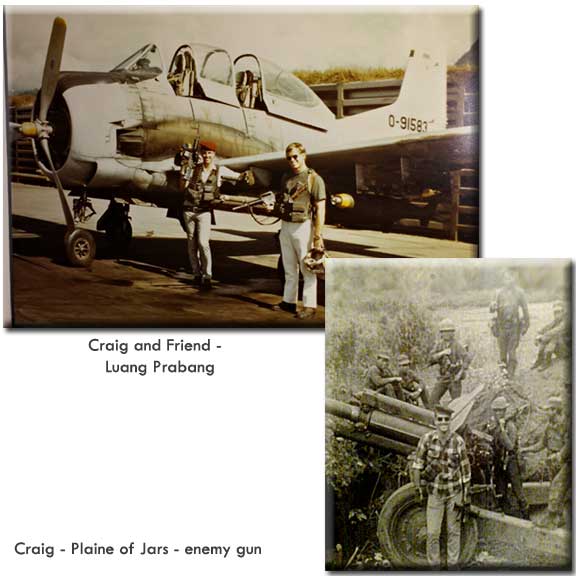
National Service (Extract from Craig’s Official Biography)
In 1972, Captain Bradford returned from extended combat operations in Southeast Asia to Williams Air Force Base in Arizona, where he served as the Chief of T-38 Operations in an Undergraduate Pilot Training Wing assigned to the USAF’s Air Training Command. The USAF then selected him in 1974 to become an Air Staff Trainee (ASTRA), where he served for two years in the Pentagon under General Dutch Huyser and was promoted to the Chief ASTRA position as General Huyser’s Junior Executive Officer. He subsequently was assigned in 1976 to Mountain Home Air Force Base to fly the F-111F fighter. The entire wing moved in 1977 to Royal Air Force Base Lakenheath. Major Bradford initially served as the Chief of the Nuclear Alert Facility, and then became the Chief of Weapons/Tactics, a Flight Commander, and subsequently an Assistant Operations Officer in the 493rd Tactical Fighter Squadron until May of 1980. He graduated from the Armed Forces Staff College at Norfolk, Virginia in 1981 with assignment to the Deputy Chief of Staff of Plans and Operations at the Pentagon. Between 1981 and early 1984, along with an early promotion in grade, Lieutenant Colonel Bradford served in the Pentagon as an Air Staff Near Term War-Planning Strategist and a counter-terrorism planner for the Office of the Joint Chiefs of Staff. From 1984 through 1985 he was appointed in “secunded” status to the Reagan Administration as the Military Assistant to the Director of Politico-Military Affairs at the U.S. Department of State and the Executive Branch. He returned to the field in late 1985 to serve for two years as the Special Assistant to the Wing Commander and later the Chief of Staff in a large F-16 wing at Nellis Air Force Base. In 1988 and upon graduation with honors from the Industrial College of the Armed Forces at the National War University in Washington, DC, President George Bush Sr. appointed Colonel Bradford to serve as a senior diplomat to the Republic of Egypt, where he spent almost two years commanding several USAF Technical Assistance Field Teams (squadrons) and equipping/training the Egyptian Air Force in close coordination with the U.S. Central Command’s General Norman Schwarzkopf. During this period, Colonel Bradford and his counterpart in Saudi Arabia became the first two Joint Specialty Officers appointed by the United States Congress. At the commencement of activities related to the impending Gulf War against Iraq’s Saddam Hussein, Colonel Bradford returned to Nellis Air Force Base in 1990 to assist Major General Billy McCoy at the USAF Weapons Center (now the U.S. Warfare Center) to prepare the United States and allied tactical forces for joint combat operations in Southwest Asia. After the Gulf War Conflict and a defining U.S. Congressional mandate requiring the military services to downsize, Colonel Bradford created a quality improvement management model to maintain combat effectiveness. His reorganization of Nellis Air Force Base during this process won a “United States Senate Productivity Award,” a first for any government organization. His model then led to an institutional merger between the USAF’s Tactical Air Command and Strategic Air Command into the new Air Combat Command. Colonel Bradford was selected by the USAF Weapons Center in 1992 as its “Officer of the Year.” He retired from active military service for medical reasons on January 31, 1993 after 24 years of active duty.
Colonel Bradford is a highly decorated career veteran of three combat tours, a unit commander, and command fighter pilot. Having logged 576 combat missions in three different theaters of war, he accumulated nearly 3,500 hours in jet fighter aircraft, the last of which was the F-16 Fighting Falcon. His military decorations include, among others, the Legion of Merit, seven Distinguished Flying Crosses, the Bronze Star with "V" device for valor in land combat as a Forward Air Controller/Joint Terminal Attack Controller with a covert special operations program in northern Laos, the Purple Heart, the Defense Meritorious Service Medal, five Meritorious Service Medals, 16 Air Medals for valor in air combat, the Vietnamese Cross of Gallantry with Bronze Star and Gold Palm, and the Order of the Million Elephants, Cavalier Rank, awarded by the King of Laos. Colonel Bradford entered the U.S. Air Force in 1968, served a full career with accelerated promotions, and retired as a 100% disabled combat Veteran.
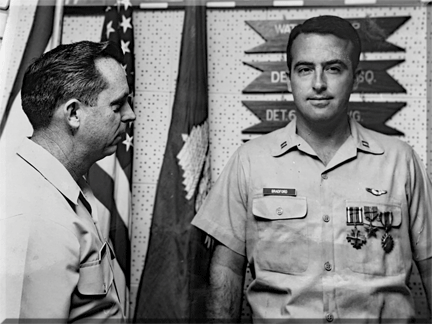
Craig receiving two Distinguished Flying Crosses (medal with a star to denote two awards)
next to a Purple Heart. Also a Bronze Star for Valor that had been submitted by the CIA for my ground actions during the famous Saint Valentines’ Day Massacre at Long Tieng, Laos months before.
Executive Branch of the United States
On behalf of President Ronald Reagan, Secretary George Schultz presented Colonel Bradford with the U.S. State Department’s Tribute of Appreciation in 1985 for his service to the Director of Politico-Military Affairs and to the President of the United States.
Non-Military
I married Sharon Ann Cokely in 1973 upon returning from nearly three years in combat. She graduated in 1963 from Mills High School (Millbrae, CA). We met in church in 1973 when I was assigned as a T-38 instructor pilot at Williams AFB. We eventually had three children, two boys and a girl. My youngest son passed away soon after graduating from the U.S. Air Force (USAF) Academy. Our oldest son also graduated from the Academy with honors and a degree in astronautical engineering, and subsequently earned a masters degree in aeronautical engineering via a graduate program with NASA. All three children were celebrated athletes, thanks to Sharon’s gene pool. While at the Academy, both sons went on LDS missions after their sophomore years. The oldest went to Moscow for two years, and the other went to Venezuela for the same amount of time. Our oldest son became a top graduate of the USAF Test Pilot School and recently retired from the USAF from his senior position at the USAF’s Space Command in Los Angeles. He now works as an engineer for the Aerospace Corporation at Hill AFB in Ogden, Utah. He, his wonderful wife, and 5 of his 6 children live only 30 minutes from us in Mountain Green, which is why we ended up in Utah. Our beautiful daughter is a popular television commentator living in Iowa who focuses on investment strategies. Her husband is a regional investment star. Their son is two years old. Seven grandchildren in all.
Craig is a 1981 graduate of England’s Cambridge University (Squire Law School) via a 3-year program granted by the University of Southern California that resulted in an International Relations (Law) degree. He has been the owner of Bradford & Associates International between 1990 and licensed to practice law at the Hague, the Deputy City Manager of North Las Vegas between 1993 and 1996, a corporate CEO in the private sector between 1999 and 2005, the appointed administrator of a California Joint Powers Authority between 2001 and 2005, and served as an elected official in Del Norte County between 2005 and 2019. Craig became a “FEMA Director of Record” during a large, 6-year public safety project to stabilize a mountain threatening to collapse upon the Township of Hiouchi just across the Smith River from Joe and Diane Falcone. From 2007 to 2019, he served as the Chairman of the Del Norte Water Resources Network.
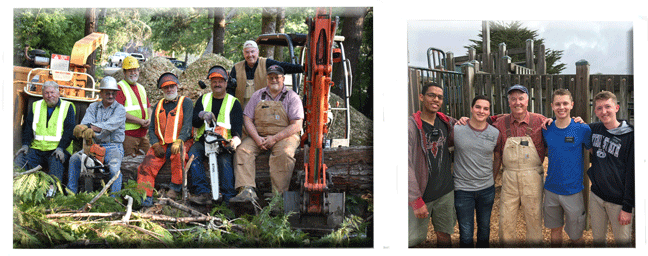
Volunteer crew cleared 5 acres in 5 days to host 200,000-gallon water tank system, plus the Hiouchi Mountain Radio station. The group was dubbed "The Magnificent Seven." |
Four missionaries helped Craig refurbish Kidtown in Crescent City after being damaged by a nasty storm. |
Craig and his wife currently live in Eden, Utah as the Emergency Communications Coordinator for Ogden Valley, which covers four townships. Craig has been asked to lead the creation of a new county in northeastern Utah with a jurisdiction that is limited to Ogden Valley.
On a Personal Note (to answer Lynda’s questions)
My favorite memory (after my dad had been granted custody when I was 13) was building and flying U-Control model airplanes with my stepbrother in-between fishing and hunting trips with my incredible dad. My stepmother, Anne, was also quite special, and I loved her dearly.
When asked, “Who inspired me?” The quick answer is “generally my religious beliefs and specifically my dad, Coach Giddings, my church Stake President, and the USAF.” And, it always helped to confide in Joe Falcone, Dave Buck, Dave’s mom, and Leroy Ward.
Hobbies are woodworking, fly-fishing, and hunting.
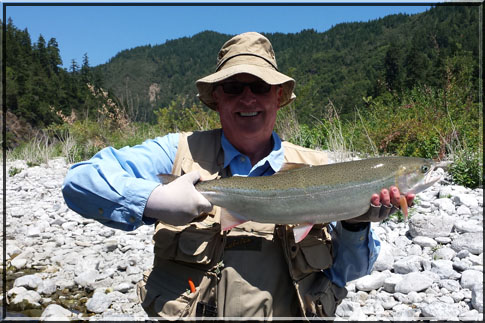
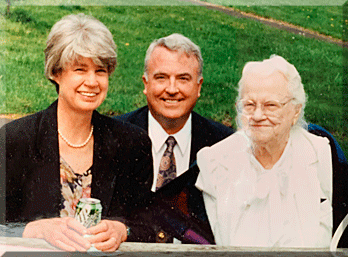
Craig, one of many who volunteer to drive elderly widows the many miles
over the Coastal Range to attend Temple in Medford.
How many moves? I’ve moved 28 times over my post-high-school career, and Sharon has moved 14 times with me since we were married. Lived in Laos, Vietnam, Thailand, the Philippines, Austria, Germany, England, Mexico, Egypt, and all over the United States. Our kids became fluent in Russian, Spanish, and Arabic. We’re not moving again . . . not ever, that is.
Maintained friendships? Our classmates who we know have remained in touch, more or less. The Nootebooms are a good example. Fred traveled all of the way up to Del Norte County to fly fish with Joe Falcone and me. Dave Thompson recently visited us in Utah. My best friends on this Earth remain you, Leroy Ward, Tony and Barbara Fiorentino, Diane Falcone, Dave Thompson, Dan Montgomery, Fred and Sherrie Nooteboom, and Dave Buck. I miss Joe Falcone more than ever. All of us communicate and/or visit each other when convenient.